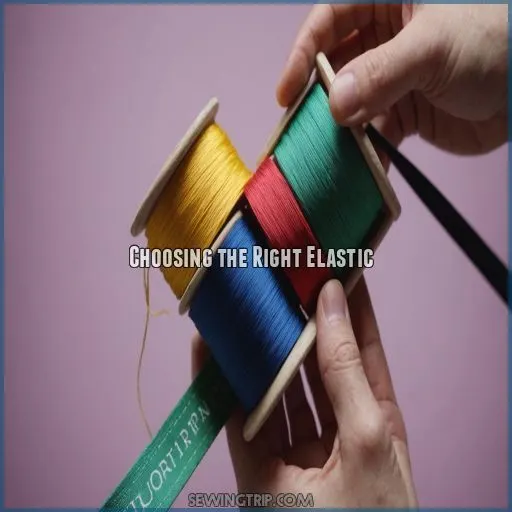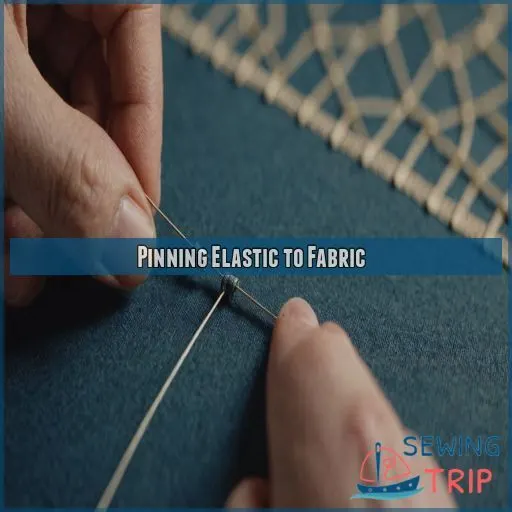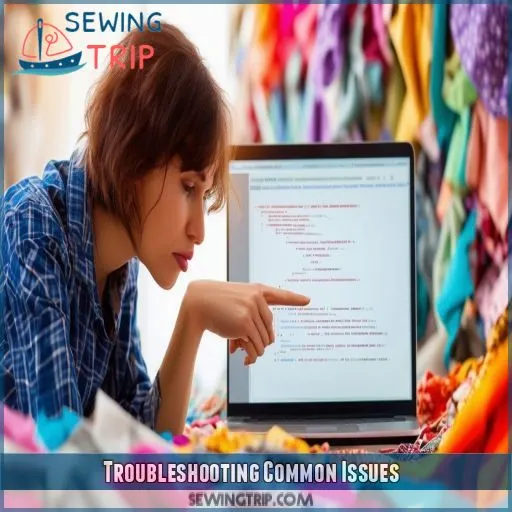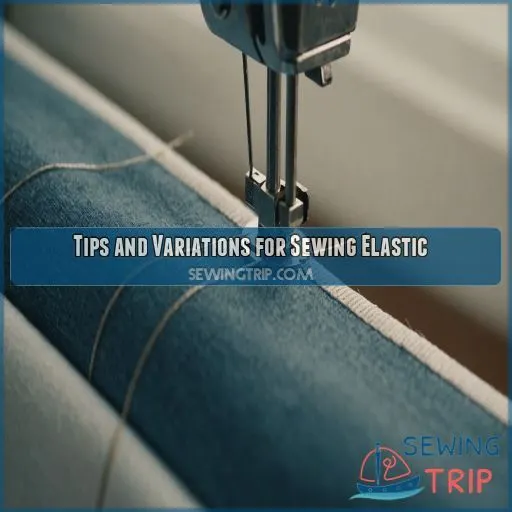This site is supported by our readers. We may earn a commission, at no cost to you, if you purchase through links.
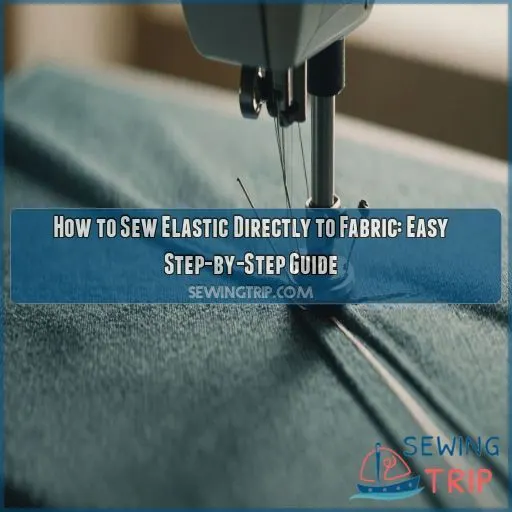
Braided or knitted elastic is great for comfort, while woven elastic is better suited for heavy-duty projects. If you want an invisible finish, clear elastic is the way to go.
Next, measure the area where you’ll add the elastic and cut it with a rotary cutter. Make sure to overlap the ends for a secure fit.
Pin the elastic to your fabric, making sure to distribute it evenly. Then, use a zigzag stitch to sew it on, adjusting the tension and length as needed.
With a little practice, you’ll be adding stretchy, professional-looking elastic to all your garments in no time!
Table Of Contents
- Key Takeaways
- Choosing the Right Elastic
- Preparing Your Fabric
- Measuring and Cutting Elastic
- Dividing Elastic for Even Distribution
- Pinning Elastic to Fabric
- Sewing Elastic Directly to Fabric
- Troubleshooting Common Issues
- Finishing the Hem With Elastic
- Tips and Variations for Sewing Elastic
- Frequently Asked Questions (FAQs)
- Conclusion
Key Takeaways
- Choose the right elastic for your project – braided, knitted, or woven – based on your fabric’s needs and the project’s purpose. Woven elastic is perfect for heavy-duty projects that require extra durability.
- Measure and cut your fabric and elastic precisely using a rotary cutter and measuring tape. Overlapping the elastic ends is crucial for a secure fit.
- Distribute the elastic evenly across your fabric by dividing it into sections with pins. Adjust the tension as you sew to achieve a smooth, professional-looking gather.
- Use a zigzag stitch to sew the elastic directly onto your fabric. Sewing from the right side gives you better control for a clean, even seam. Troubleshoot any issues, such as uneven gathering or elastic pulling out, by adjusting your technique.
Choosing the Right Elastic
When sewing elastic directly to fabric, picking the right type of elastic is crucial for the success of your project.
It can make or break your project, so don’t let stretchy decisions leave you in knots.
To avoid this, choose elastic that matches your fabric and project needs, and you’ll be good to go.
Types of Elastic for Sewing
When sewing, choose the right elastic – braided, knitted, or woven – based on your fabric’s needs and the project’s purpose.
Braided Elastic Vs Knitted Elastic
Choosing between braided and knitted elastic can be a stitch in time. Knitted elastic offers more comfort, durability, and elasticity.
Woven Elastic for Heavy-Duty Projects
For heavy-duty projects, woven elastic is your best friend. Its strength matches thicker fabric weights, making it an ideal choice for projects that require extra durability.
Key Features of Woven Elastic
- Strength comparison: Woven elastic has a comparable strength to thicker fabric weights.
- Suitable for thicker fabrics: It is designed to work well with heavier fabrics.
- Fashion elastic option: Woven elastic is a popular choice for fashion projects that require a bit of stretch.
- Ideal for heavy-duty uses: It is perfect for projects that need to withstand heavy use and stress.
Working with Woven Elastic
Use a rotary cutter for precision when working with woven elastic to ensure accurate cuts and a professional finish.
Elastic Thread or String for Delicate Fabrics
Leaving the heavy-duty woven elastic behind, elastic thread is perfect for delicate fabrics. It’s great for hand sewing invisible seams on gentle projects!
Clear Elastic for Invisible Seams
clear elastic is perfect for delicate fabrics, sheer styles, or when you want a seamless look. It creates an invisible seam, making it ideal for various applications.
Key Features of Clear Elastic
- Lightweight and flexible
- Virtually disappears into fabric
- Ideal for waistbands, cuffs, and hems
- Stretches comfortably without visible stitching
Preparing Your Fabric
Before you start sewing, get to know your fabric like it’s a new friend.
Fragile silks and sturdy denims have different needs. This means you’ll need to approach each type of fabric with care and attention to its unique requirements.
Measure twice and cut once, because nobody wants to end up with a hemline that’s as crooked as a politician’s smile.
Selecting the Right Fabric for Elastic
Picking the right fabric is like choosing the perfect dance partner – smooth moves matter.
Consider the fabric’s weight, stretch, drape, and weave.
Make sure it’s compatible with your elastic.
Balancing fiber content guarantees you’ll waltz through sewing seamlessly.
Measuring and Cutting Fabric Accurately
Now that you’ve chosen the right fabric, it’s time to measure and cut accurately.
Mind the fabric grain and use quality cutting tools.
A measuring tape helps you get perfect seam allowances.
Interfacing and Stabilizing Fabric for Elastic
Interfacing can stabilize lightweight fabrics, ensuring your elastic seams stay put.
Choose a fusible interfacing that matches your fabric’s weight and stretch.
This creates a sturdy base for your elastic projects.
Measuring and Cutting Elastic
Before you can stitch your elastic masterpiece, you’ve got to measure and cut it just right. No one wants a waistband that snaps like a slingshot.
Grab your tape measure and rotary cutter, and let’s make sure your elastic fits perfectly.
The goal is to avoid a waistband that bounces back like a bad joke.
Calculating Elastic Length for Your Project
After choosing your fabric, let’s tackle calculating the elastic length.
You’ll need to keep in mind the following factors to determine the correct elastic length.
- Garment Size: Measure the waist or desired area where the elastic will be placed.
- Stretch Factor: The elastic should stretch comfortably to fit the wearer’s body.
- Seam Allowance: Add extra length for overlap and sewing to ensure a secure fit.
Cutting Elastic With a Rotary Cutter and Mat
Got your elastic length?
Grab a rotary cutter for precise cutting.
A sharp blade‘s your secret weapon, and a proper mat size makes sure straight lines, no crooked elastic escapades here.
Overlapping and Sewing Elastic Ends
To create a strong attachment point for your elastic, always overlap the elastic ends.
This helps prevent the elastic from stretching out over time.
Sew a sturdy box stitch to secure the elastic in place.
For a professional finish, try different zigzag variations.
Dividing Elastic for Even Distribution
To make sure your elastic is evenly distributed, divide it into sections with precision for a balanced fit.
This simple trick makes your sewing process smooth and keeps your fabric looking its best, almost like assembling the pieces of a puzzle.
Folding and Pinning Elastic for Symmetry
Imagine your elastic as a pizza; folding it makes sure the slices (your fabric) are even.
Proper pin placement leads to flawless fabric gathering.
Creating Even Sections With Pins
To master the pinning technique, divide the elastic evenly with pins.
Align these pins with fabric folds, creating balanced sections.
Imagine elastic sections as pizza slices – you don’t want a lopsided pie. This helps maintain consistent gathering effects.
Adjusting Elastic Tension for Smooth Gathering
To achieve a smooth, uniform look and feel, it’s essential to stretch the fabric as you sew. This technique helps create an even texture and prevents puckering.
When sewing, use a slightly longer stitch length. This allows for a more flexible seam and helps the fabric lie flat.
To prevent uneven gathering, adjust the elastic tension. This ensures that the fabric gathers evenly and doesn’t pucker or distort.
- Stretch fabric as you sew
- Use a slightly longer stitch
- Adjust tension for even gathering
- Relax, practice makes perfect!
Pinning Elastic to Fabric
Pinning elastic to fabric can feel like wrangling a playful cat, but with a bit of patience, you’ll have it under control in no time.
Aligning Elastic With Fabric Folds
Take your elastic and fabric, and like old friends meeting for coffee, align them.
Match the pin markers with the fabric’s folds.
You’re the conductor; keep sections and tension balanced for a smooth gathering masterpiece.
Securing Elastic With Minimal Pins
You’ve aligned with fabric folds. Now, secure the elastic with minimal pins for control.
Follow this checklist to achieve a smooth finish:
- Pin loosely to allow fabric stretch.
- Focus on gathering control.
- Use elastic tension wisely.
- Enjoy a smooth finish.
Smoothing Fabric for Even Gathering
Smoothing the fabric before sewing helps create even gathers. This is an essential step in achieving a professional finish.
Pinning the Elastic
Pinning the elastic at strategic points helps control tension. This ensures that the gathers are evenly distributed and the fabric lies flat.
The 3×5 Stretch Test
Try this 3×5 stretch test to check fabric smoothness:
| Pin Placement | Fabric Tension | Gather Evenness |
|---|---|---|
| Centered | Relaxed | Smooth |
| Uneven | Tight | Uneven |
| Overlapping | Loose | Wavy |
Finishing the Gathers
Finish by pressing the pinned area to set the gathers. This helps create a crisp, smooth finish that will last.
Sewing Elastic Directly to Fabric
Mastering the art of sewing elastic directly to fabric gives your projects a snug fit and a professional finish, and can be done with a few simple steps.
A professional finish is just a few stitches away. Grab your sewing machine and get ready to zigzag your way to perfectly gathered edges.
No elastic retreats allowed!
Choosing the Right Stitch for Elastic
Choosing the right stitch for elastic can feel like Goldilocks finding the perfect porridge.
Balancing stitch length and tension is a must, since the elastic’s stretch can vary.
Opt for a zigzag width that complements and a needle size that fits.
Using a Zigzag Stitch for Elastic Attachment
Adjust zigzag stitch tension and length based on fabric thickness and elastic width.
Use a proper seam allowance to make sure you get good results.
Sewing From the Right Side for Better Control
Sewing from the right side gives you better control over the stitching. You can see the elastic as it feeds under the needle, ensuring a smooth, even seam. This helps prevent puckering or uneven gathering.
To achieve this, follow these key steps:
- Maintain consistent tension
- Adjust needle position as needed
- Monitor fabric movement carefully
- Stitch slowly for precision
Troubleshooting Common Issues
You’ve pinned and stitched, but sometimes that pesky elastic just doesn’t behave. Don’t worry—I’ve got some quick tricks to keep your elastic in line and stop it from misbehaving!
Preventing Elastic From Pulling Out of Fabric
The zigzag stitch is the elastic’s best friend, keeping it snug and secure. Achieving just the right elastic tension prevents unraveling.
When working with elastic, consider the fabric weight; heavier fabrics need a robust grip.
To ensure a secure fit, mind the seam allowance and choose a thread type that matches your project, avoiding tears. Keep everything tight and together!
Fixing Gathered Fabric With Uneven Elastic
If your fabric’s gathering like a stormy sea, don’t panic. Take charge and fix uneven gathering by following these steps:
- Adjust pins: Make sure they’re evenly spaced for balanced tension.
- Re-sew elastic: Keep an even stretch to prevent lopsided wrinkles.
- Stretch fabric gently: Adjust as needed for a smoother finish.
Finishing the Hem With Elastic
You’ve completed the first step of sewing the elastic directly onto the fabric.
Now, it’s time to finish the hem.
To achieve a professional look, simply turn up the edge of the fabric to create a neat, crisp fold, and press it in place.
Turning Up the Elasticated Hem
Once your elastic’s securely sewn, give your hem a fancy turn-up.
Just fold the fabric under the elastic edge, embracing classic hemming techniques.
You’ve got fold types aplenty to choose from, but a simple tuck’ll do the trick.
Secure with your chosen stitch option, ensuring seam finishes that look professional.
Done!
Pressing the Hem for a Crisp Fold
You’ve turned up the hem, now it’s time to press it for a crisp fold.
Adjust your iron’s steam setting and temperature based on the fabric type – don’t fry it!
Grab your pressing tools and tackle that hem allowance. A well-pressed hem is like the perfect handshake, confident and neat.
Tips and Variations for Sewing Elastic
When you’re ready to add some elasticity to your sewing projects, getting creative with your techniques can make all the difference.
Whether you’re sewing by hand or using string for invisible seams, these tips will have your fabric snapping back like a rubber band in no time.
Sewing Elastic by Hand for Delicate Projects
For delicate fabrics, hand-stitching elastic is a breeze. Choose a fine needle, adjust thread tension, and stitch slowly for a polished finish. The personal touch makes it extra special.
Using Elastic Thread or String for Invisible Seams
Switching gears from hand-sewing, let’s chat elastic thread types.
For invisible seams, choose thin threads to match. This is especially important when working with delicate fabrics.
Delicate fabric use needs gentle tension control, tight but not too snug. This balance is crucial for achieving a professional finish.
Think projects like airy blouses or dainty dress hems, where a delicate touch is essential.
Creating a Casing or Channel for Elastic
Think of a casing like a cozy tunnel for your elastic.
To sew a casing, consider the following steps:
- Choose the right fabric type
- Measure the casing width
- Determine channel placement
- Focus on neat finishing details
Embrace creativity and control!
Frequently Asked Questions (FAQs)
What is the best stitch to attach elastic to fabric?
Sewing elastic can be a challenging task.
It’s often compared to taming a wild horse because it requires a delicate balance between control and flexibility.
The key to successfully sewing elastic is using a zigzag stitch.
This type of stitch gives the elastic flexibility while holding firm, preventing it from slipping and losing its shape.
How do you sew elastic directly to fabric by hand?
Attaching elastic by hand is a breeze.
To start, you’ll need to overlap elastic ends and sew securely. This will ensure a strong bond between the two ends of the elastic.
Next, align and pin it evenly to your fabric. This step is crucial in achieving a smooth, even gather.
Finally, use a backstitch for firm attachment. This type of stitch will provide a secure hold and prevent the elastic from coming loose over time.
With these simple steps, you’ll have a perfectly gathered garment in no time.
How do you sew elastic to gather fabric?
Gather your fabric and elastic.
Pin the elastic evenly across the fabric.
Sew it on with a zigzag stitch, allowing the fabric to gather as you go.
Voila – a perfectly gathered look!
How to sew elastic evenly?
Think of elastic as the skeleton of your project, strong and supportive.
To distribute it evenly, divide both fabric and elastic into quarters with pins, aligning them precisely.
This makes sure smooth and balanced tension throughout, like magic.
What types of fabric work best with elastic?
You’ll get the best results using stretchy fabrics like jersey, spandex, and cotton blends with elastic.
They move and groove with the elastic, so you won’t feel like you’re fighting a losing battle.
How do you clean elastic-sewn garments?
Cleaning elastic-sewn garments is like nurturing a garden.
Use gentle cycles and cold water, avoiding harsh detergents.
Keep them blooming longer by air drying.
Treat your clothes with care and they’ll serve you well, rain or shine.
Are there sustainable alternatives to elastic?
Try using sustainable options to reduce your environmental footprint.
These eco-friendly alternatives include organic cotton tape, bamboo knit, or recycled polyester.
They provide the same stretch and support as traditional elastic.
Get creative and experiment to find the perfect fit.
Can elastic be reused from old garments?
Repurposing elastic from old garments is a great idea, but it’s essential to be caution-conscious.
Carefully collecting the elastic is crucial to prevent wear and weakness.
This approach can be thought of as thriftiness with a twist, allowing you to save scraps and stretch your sewing skills.
What are common elastic sewing mistakes?
You might sew elastic unevenly, leading to nasty puckering.
Forgetting to stretch the elastic while sewing is a recipe for disaster.
And don’t skip pinning – it’s your best friend for keeping everything aligned smoothly.
Conclusion
Did you know that 90% of home-sewn garments use some form of elastic? Now, you’re ready to join this trend.
With this guide on how to sew elastic directly to fabric, you’re equipped to elevate your sewing projects.
Choosing the right elastic and using a zigzag stitch are key steps. Don’t rush – practice makes perfect!
Soon, you’ll confidently add that stretchy, professional touch to your creations.
Happy sewing, and enjoy your seamless elastic experiences!

